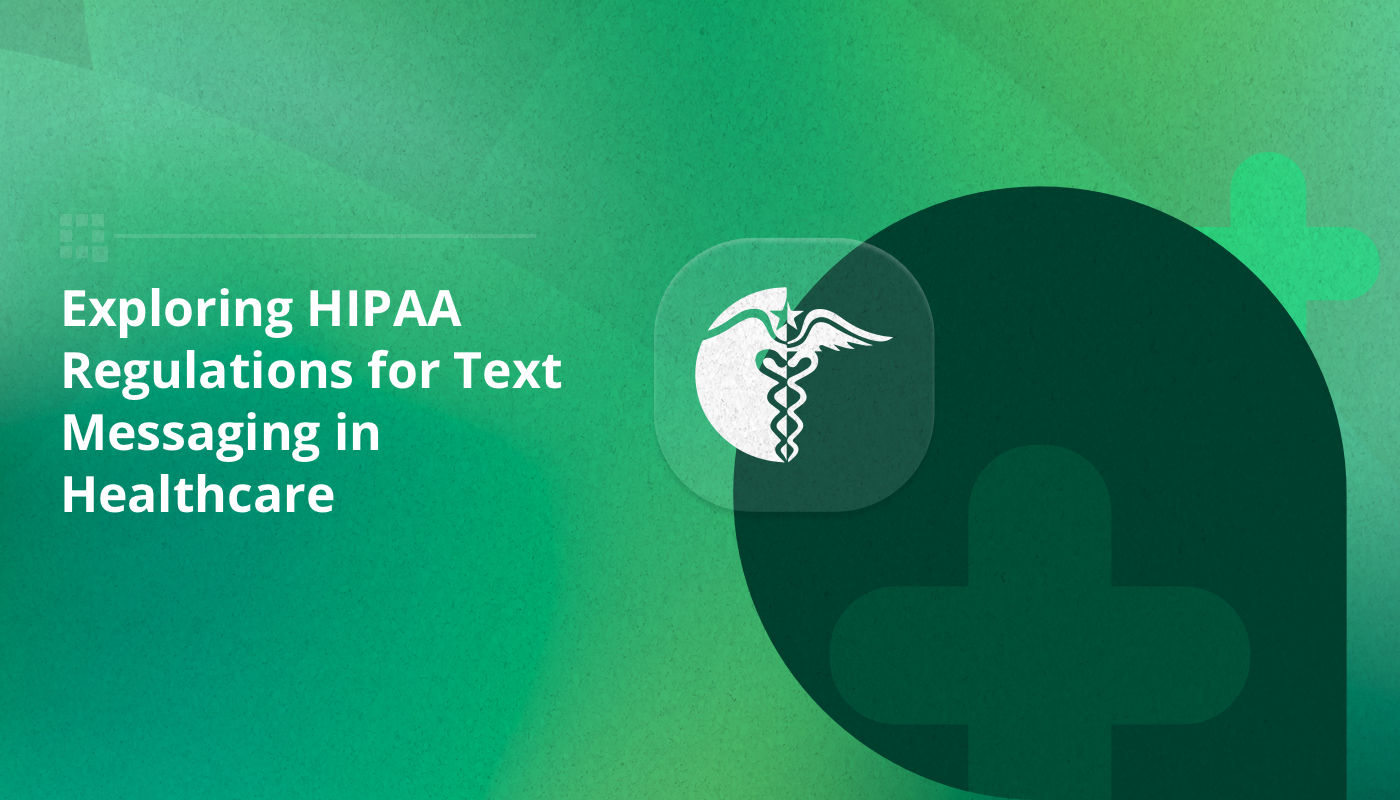
Summary: This article explores critical HIPAA guidelines for texting in healthcare. Text messaging plays an important role in enhancing patient engagement and operational efficiency, but HIPAA compliance is a must. This article will outline the top HIPAA regulations for text messaging and the best practices for implementing and maintaining a compliant messaging platform. Looking to the future, it addresses how emerging technologies and evolving HIPAA texting policy will shape the use of text messaging in healthcare.
Table of Contents
Introduction
Text messaging has become a cornerstone of our daily communication, loved for its convenience and immediacy. It’s no wonder then that doctors and patients are turning to this method for quick, efficient exchanges. Texting a clinic to confirm the time of your appointment, or messaging with a therapist for mental health support are obvious ways that this form of digital communication can be extremely effective for healthcare delivery.
However, as healthcare providers embrace the ease of texting, they also need to remain mindful of a significant responsibility: safeguarding patient information. Including information that can help reveal the identity of a patient within a text message (known as electronically Protected Health Information or ePHI) carries the risk of breaking patient confidentiality. HIPAA legislation imposes severe penalties for organizations that don’t take the necessary steps to safeguard ePHI. This blog explores the critical importance of HIPAA compliance in healthcare text messaging, offering insights into how medical professionals can harness the benefits of text messaging while ensuring the highest standards of patient data protection.
Texting in Healthcare
Text messaging has become a very useful tool in the context of healthcare allowing healthcare providers and patients to connect quickly and effectively. Effective use of text messaging can greatly improve patient participation, care quality, and operational efficiency. Not only does text messaging facilitate communication between patients and doctors, but it also plays a critical role in improving communication between healthcare providers. Let’s examine some of the numerous functions that text messaging performs in healthcare settings.
1. Appointment Reminders
Patients and healthcare providers alike may incur high costs as a result of missed visits. Patients can be effectively reminded of forthcoming appointments by text messaging, which also lowers no-show rates and guarantees that patients receive the necessary care. Text message reminders have been proven in studies to greatly increase appointment adherence.
2. Medication Adherence
Patients frequently neglect to take their prescriptions as directed, which can worsen existing medical conditions and raise the expense of healthcare. Patients can follow their specified treatment plans by using text messaging to receive prescription reminders. Studies show that patients are more likely to take their prescriptions correctly when they get text message reminders.
3. Health Education and Preventive Care
Text messaging can be used to give patients lifestyle advice, preventive care recommendations, and educational materials regarding their medical concerns. By being proactive, people are better able to manage their health and require fewer emergency room visits. For example, initiatives to use text messages to encourage people to get flu vaccinations have shown positive results, demonstrating the potential of text messaging as a useful tool for promoting preventative care.
4. Coordination of Care
Text messaging is an effective way for healthcare practitioners to coordinate treatment, particularly when there is a need for prompt decision-making. For instance, a physician can text a specialist with a patient’s condition to ensure prompt and well-coordinated therapy.
5. Staff Communication
Healthcare facilities can improve internal communication by using text messaging. Employees can communicate essential information, plan shift changes, and exchange critical updates using text messages, which increases overall operational efficiency.
6. Emergency Alerts
Text messaging is a useful tool for promptly informing patients and staff about emergencies. Hospitals, for instance, can employ text messaging to alert workers about emergency codes, closures due to inclement weather, or other critical situations that call for rapid attention.
HIPAA Guidelines for Text Messaging
To protect patient privacy and security, text messaging in the healthcare industry must adhere to HIPAA laws. HIPAA outlines a series of administrative, physical, and technical measures necessary to ensure that ePHI is safeguarded. Accordingly, healthcare businesses are required to follows these rules so that texting and other forms of digital communication with patients remain compliant. The main HIPAA rules governing text messaging in healthcare settings are examined here.
1. End-to-End Encryption
Encryption is the cornerstone of a HIPAA-compliant texting policy. Messages are safely encrypted from the time they are sent until the intended recipient receives them. This prevents unauthorized parties from accessing ePHI while it’s being transmitted. Encryption ensures that sensitive information stays private even if it is intercepted by converting the message content into a coded format that can only be decoded by someone with the right decryption key.
2. Access Controls
Access controls are essential for ensuring that only authorized individuals can access ePHI. This involves implementing:
- Personalized User IDs: Giving each user a unique ID allows you to keep tabs on their activity and access.
- Password Guidelines: Requiring strong passwords that need to be changed on a regular basis in order to stop illegal access.
- Multi-Factor Authentication (MFA): This technique adds an additional layer of protection by asking users to confirm their identity using two different ways, like a password and a one-time code texted to their phone.
3. Audit Trails
Healthcare organizations are required by HIPAA to keep audit trails in order to track who has access to and uses ePHI. All contacts with ePHI are documented via audit trails. These documents support accountability, breach investigation, and illegal access detection. Audit logs should include:
- Message Content: The actual text of the messages.
- Timestamp: The date and time each message was sent and received.
- User Information: Identifying the sender and recipient of each message.
4. Integrity Controls
Integrity controls prevent unauthorized changes to or destruction of ePHI. This involves implementing measures that:
- Verify Message Integrity: Ensure that the message content remains unchanged during transmission.
- Secure Storage: Protect stored messages from tampering or unauthorized access.
For instance, hashing algorithms are used by secure messaging apps to confirm message integrity, making it possible to identify and resolve any unwanted alterations to message content.
Best Practices for Ensuring HIPAA Compliant Texting
Now that we understand the key elements of HIPAA guidelines that relate to the use of text messaging, we also need to consider the best practices for implementing and maintaining a HIPAA compliant platform. By following best practices, healthcare organizations can safeguard ePHI and mitigate the risk of data breaches.
1. Implement a Secure Messaging Platform
Most obviously healthcare professionals would do well to utilize a secure messaging platform specifically designed for healthcare. Texting to and about patients on third party apps like, Whatsapp or facebook messenger just won’t cut it. Secure messaging platforms typically offer features such as encryption, user authentication, and audit logs, that meet HIPAA requirements. They also provide a secure environment for healthcare providers to exchange ePHI without risking data breaches.
2. Regularly Assess Risks
It is also vital that Healthcare organizations perform regular audits and risk assessments to keep their messaging systems compliant and secure. These assessments involve reviewing the effectiveness of current security protocols and identifying potential threats to ePHI.
3. Monitor and Audit Text Messaging Activities
Maintaining audit trails and regularly monitoring text messaging activities helps detect unauthorized access and potential breaches. For instance, it is possible to implement automated monitoring tools that can alert administrators to suspicious activities and provide detailed audit reports.
4. Update Software to Address New Security Threats
Ensuring that your chosen messaging platform is regularly updated is crucial for maintaining HIPAA compliance. Cybersecurity threats are constantly evolving, with new vulnerabilities and attack methods emerging regularly. If a messaging platform is not kept up to date with the latest security patches and updates, it becomes increasingly vulnerable to these threats, potentially exposing sensitive patient data to unauthorized access.
The Future of Text Messaging in Healthcare
The use of text messaging in healthcare is anticipated to grow and change as a consequence of technology advances, shifts in the legal environment, and the continuous need to improve patient participation and care coordination. Let’s consider some possible developments and trends that could affect text messaging in healthcare in the near future.
1. Integration with Emerging Technologies
Text messaging systems that incorporate AI have the potential to transform healthcare communication. AI Chatbots can make appointments, send patients medication reminders, and instantly respond to frequently asked questions. Proactive care is also made possible by Machine Learning algorithms that can examine text messages to find patterns and anticipate patient requirements.
Text messaging platforms can also be connected with IoT devices, including wearable health monitors, to give patients and clinicians real-time health updates. If these gadgets detect changes in a patient’s condition, they can automatically send notifications, allowing for early actions.
2. Enhanced Security Measures
The security protocols defending ePHI in text messaging need to be continuously updated in tandem with the ongoing evolution of cyber threats. To improve data security and integrity, future secure messaging services should likely include blockchain technology, biometric verification, and sophisticated encryption techniques.
3. Regulatory Changes and Compliance
The regulatory environment pertaining to communication in healthcare is always changing. Future modifications to HIPAA standards could result in stricter text messaging restrictions, which would force healthcare firms to implement even more security safeguards and compliance procedures.
4. Increased Focus on Patient-Centered Care
Text messaging will continue to play a crucial role in enhancing patient-centered care. Personalized communication strategies, enabled by data analytics and AI, will allow healthcare providers to tailor messages to individual patient needs and preferences, improving engagement and adherence to treatment plans. For example, personalized text messages that consider a patient’s medical history, preferences, and current health status can improve medication adherence and encourage healthier behaviors.
5. Expanding Use Cases
The use cases for text messaging in healthcare will expand beyond appointment reminders and medication adherence. Text messaging may be used in the future to support the treatment of particular illnesses. For example, text messages can provide patients with mental health issues a discreet and convenient method to get help, or they can give patients managing chronic disorders like diabetes or hypertension ongoing support and education.
6. Global Reach and Accessibility
Text messaging is an excellent technique for reaching underserved and remote populations since it provides an affordable and generally accessible form of communication. Text messaging will be essential in bridging healthcare gaps and giving individuals in need quick information and support as mobile phone usage continues to rise globally.
Conclusion
Text messaging has a bright future in healthcare, as there are many ways to improve patient care, expedite communication, and guarantee regulatory compliance. Healthcare businesses may fully realize the promise of text messaging to enhance patient happiness and health outcomes by adopting cutting-edge security measures, embracing developing technology, and concentrating on patient-centered communication. Text messaging will remain a vital tool in the world of digital healthcare as we move forward.
QuickBlox is a good option if you’re trying to create a secure messaging platform for healthcare that complies with HIPAA regulations. Strong, safe, and adaptable message solutions are offered by QuickBlox, which are made to satisfy the exacting standards of healthcare communication. QuickBlox helps you comply with HIPAA standards by protecting patient information with features like encryption, access controls, and audit trails.
Talk to a sales expert
Learn more about our products and get your questions answered.
Contact sales








